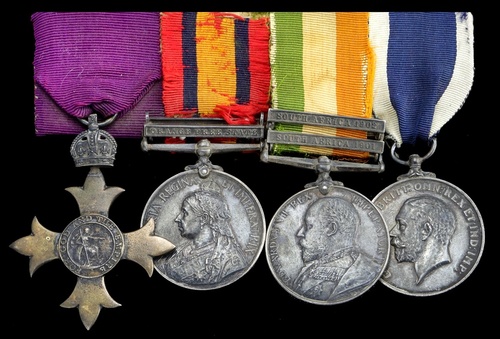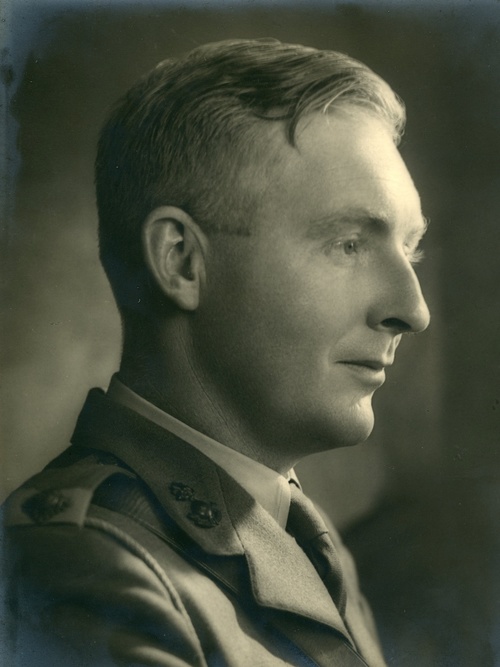Auction: 18001 - Orders, Decorations and Medals
Lot: 352
Sold by Order of a Direct Descendant
A Second World War campaign group of six awarded to Lieutenant D. A. Gray, South African Engineer Corps, who was mentioned in despatches for services in the Western Desert
Otherwise a talented artist and author, 'he lived a sort of Boys' Own annual kind of life right to the end, a life filled with adventures and discoveries'
1939-45 Star; Africa Star; Italy Star; Defence and War Medals 1939-45, M.I.D. oak leaf; Africa Service Medal 1939-45, all officially impressed '24951 D. A. Gray, mounted as worn, very fine (6)
Douglas Awdrey 'Ginger' Gray was born in Bloemfontein on 5 May 1911, the son of Colonel G. D. Gray, O.B.E., K.P.M., Deputy Commissioner of South African Police. As cited above, according to recollections provided by his daughter Marianne, her father 'lived a sort of Boys' Own annual kind of life right to the end, a life filled with adventures and discoveries'. She continues:
'As a child he was bitten by General Smuts' monkey, was run over by a full-span ox wagon in Eloff Street, the main street in Johannesburg and, walking to school there, was bitten by a snake, whereupon he cut the bite with his penknife, sucked out the poison and went on to school, where, he said, he felt 'a bit sick' but didn't dare tell the master why ...'
He was educated at King Edward's School, Johannesburg, before reading mechanical engineering at Queen's College, Cambridge, where he was Captain of football and a 'demon bowler' at cricket. He then took work in Scotland and Germany, before returning to South Africa to become Personnel Manager at Barlows engineering. It was here that he became a 'Springbok Tentpegger' and became increasingly involved in horse riding. He married champion rider Isa, and settled into life at Head Office.
It seems. however, that his scrapes as a child would continue, not so much on horseback, but more with regards to his excursions into the countryside: 'As an adult, he was concussed on the head by a giraffe, ended up a tree after a rhino had chased him up it, and swam (unknowingly) with sharks in the Storms River mouth.'
During the Second World War, he served as a Lieutenant in South African Military Forces and was awarded a 'mention' for his service in the Engineers in the Western Desert (London Gazette 24 June 1943, refers). During this time, he started to foster his love of wildlife and the bush through his artistic talents, sending home to his baby son Stephen a series of illustrated stories about a little monkey called Mick. The stories and drawings were enthusiastically received by Stephen and soon became popular among cousins, friends and neighbours - 'Children can relate to Mick, who is a naughty little chap who gets into a lot of trouble.'
Gray showed his collection of drawings to the Wildlife Society for use in its children's publication, Toktokkie, and within a short period of time he had a regular two-page spread and a book to his credit. Aside from 'Mick', his characters included 'Professor Owl', the security officer, 'Horrie Hyena' and Mick's friend, 'Bertie', the velvet monkey, in addition to 'Ollie' the baby elephant, and many others.
Upon retirement, Gray devoted considerable time to the Flower Foundation, a welfare organisation concerned with setting up flats and cottages for the elderly in middle-income South Africa. As a member of the watercolour society, he continued to draw and paint, typically the wildlife of the Kruger National Park, which gave him great satisfaction. His last book, Mick the Monk and the Birds of South Africa, was published a few days before his 93rd birthday. He died on 27 December 2005 in Johannesburg.
Sold with an impressive archive of original documentation and ephemera:
(i)
Mention in despatches certificate in the name of 'Lieutenant D. A. Gray, South African Engineers Corps', dated 24 June 1943, in original O.H.M.S. envelope.
(ii)
A photocopy of an article by Jill De Villiers, titled 'Mick the Monk's origins in Western Desert'; this gives a fascinating insight into his love of art and nature and the creativity behind his books.
(iii)
A wartime portrait photograph in uniform, together with a photograph of him atop 'African Chief,' annotated to reverse 'Champion and 1st Hunter Class, Goodwood, 1956', and a photograph of him with his mother, taken whilst ice-skating on holiday in 1935.
(iv)
A comprehensive photograph album (approx.160 images; 15 watercolours), annotated in pencil, showing the places which he visited in North Africa during the war; the album commences with four photographs titled 'Spoils of War, Western Desert 1943,' showing knocked-out and abandoned heavy weaponry, before showing a vast array of images of daily life and famous places, notably Lake Timsah and the Suez Canal, Ismailia, the Coptic Church on the Nile, Syria, Baalbek, Hama, the Citadel at Aleppo, Benghazi, the Atlas Mountains, Marrakesh and Fantasia, the whole accompanied by 15 watercolour drawings of local people, typically tribesmen in traditional clothing.
(v)
An album of watercolour and pencil drawings titled to inner cover, 'Sketches in the Middle East, Morocco, Italy, Austria and central Africa, mostly during the 1939-45 War'; the album contains 77 watercolour images depicting the local people that he met during the War and the landscapes that he witnessed, particular emphasis being placed upon the variety of clothing worn and identification features such as jewellery and tattoos. The majority of images are annotated and dated in pencil and range in size up to A4. An outstanding archive.
(vi)
Approximately 20 loose photographs of landscapes and people in North Africa; a Christmas card, dated 1941, from the 44th Water Maintenance Company, S.A.E.C.
(vii)
A silver hallmarked tankard, engraved to front 'Douglas Audry Gray. May 5th, 1911.'
Please see Lot 0000 for the recipient's miniature dress medals.
Subject to 20% VAT on Buyer’s Premium. For more information please view Terms and Conditions for Buyers.
Sold for
£580









